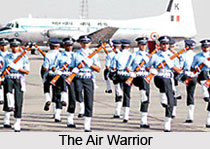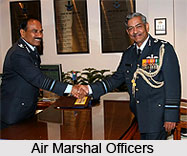 The Indian Air Force was officially established on 8 October 1932. Its first ac flight came into being on 01 Apr 1933. It possessed strength of six RAF-trained officers and 19 Havai Sepoys (air soldiers). The aircraft inventory comprised of four Westland Wapiti IIA army co-operation biplanes at Drigh Road as the "A" Flight nucleus of the planned No.1 (Army Co- operation) Squadron.
The Indian Air Force was officially established on 8 October 1932. Its first ac flight came into being on 01 Apr 1933. It possessed strength of six RAF-trained officers and 19 Havai Sepoys (air soldiers). The aircraft inventory comprised of four Westland Wapiti IIA army co-operation biplanes at Drigh Road as the "A" Flight nucleus of the planned No.1 (Army Co- operation) Squadron.
Identity of the Indian Air Force
The IAF Motto: The Motto of Indian Air Force has been taken from eleventh chapter of the Gita, the conversation given by Lord Krishna to Arjuna on the battlefield of Kurukshetra during the Great War of Mahabharata. The Lord is showing His Supreme godly form to Arjuna and the great form of the Lord is reaching the sky with glory, evoking fear and loss of self-control in the mind of Arjuna. The Indian Air Force, similarly, aims to devastate the adversary with relevance of aerospace power in defence of the nation.

The IAF Crest: Crests have been used for the purpose of acknowledgment and distinguishing formations or Units. They are symbols and source of inspiration and encouragement for the soldiers. The Air Force has adopted various crests for the commands, Squadron and the other establishments. The Crests in the Indian Air Force comprises of a standard frame. The central portion of the frame contains the individual formation sign with a motto shown in the scroll at the foot of the frame. The unit sign is drawn inside a circle. The name of the formation of the units is shown in the upper half of the circle while Bhartiya Vayu Sena inscribed if the lower half. The crest and the motto are designed based on the role of the structure. The Crest is permitted by the President of India and is of great historical and sentimental value. The Crest is normally presented by the AOsC-in-C at ceremonial parades. The importance of the crest can be understood from the fact that the movement of the crest from one place to other is done only by hand of an officer.
The IAF Flag: The Air Force flag is different from the Air Force Colors. It is blue in color, containing the National Flag in the first quadrant and a roundel consisting of the colors of the National Flag i.e. saffron, white and green in the center. This banner was adopted in 1951.
 The AIR Warriors Code
The AIR Warriors Code
•Irrespective of rank / appointment, or branch / trade, as an IAF person, the person is first and foremost an Air Warrior.
•In every act and deed, the Air Warrior places the security and honor of the country above everything else.
•The Air Warrior always volunteers for the toughest tasks.
•When ordered, the Air Warrior undertakes the assigned mission readily and aims to complete it to the best of his ability regardless of consequences to his safety.
•The Air Warrior stands by the high traditions of the IAF and always strives to bring acknowledgment to his Country and Service.
•Professionally and otherwise, the Air Warrior pursues excellence in whatever he/she does or supervises.
•The Air Warrior is always honest and lives up to the trust placed in him/her by the Service and the Country.
•The Air Warrior keeps physically fit and mentally active.

•When in Command or in-charge of subordinates, the Air Warrior leads with due concern for their safety and welfare and are prepared to do what he/she expects of them.
•The Air warrior is ideally turned-out and by his bearing and conduct endeavor to be a role model for others.
AIR Units
The branches of AIR Force Head Quarters consist of the Chief of the AIR Staff and under him there are several officers, viz:
•Vice Chief of AIR Staff (VCAS)
•Deputy Chief of AIR Staff (DCAS)
•AIR Officer In charge Personnel (AOP)
•AIR Officer In charge Maintenance (AOM)
•AIR Officer In charge Administration (AOA)
•Director General Inspection and Safety (DG I and S)

The Air Force Command is divided into Western, Eastern, Central, South Western, Southern Air Command, alongwith the Training and the Maintenance Commands. These are divided into the various geographical zones, for the better functioning of the department.
IAF Operations
Various operations carried out by this departments against the country`s enemies, are highlighted here. These include the 1947-1948 Kashmir Operations (Pre-Independence), 1962 Conflict With China, 1965 War in the Sub-Continent, 1971 Operation, Operation Meghdoot, Operation Pawan and Operation Cactus.




















